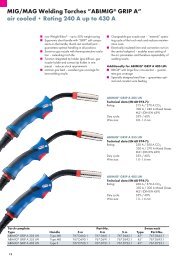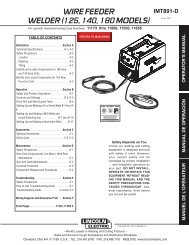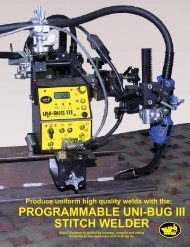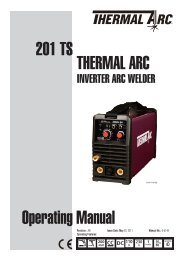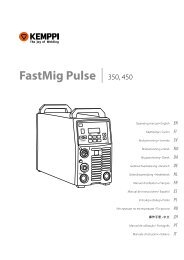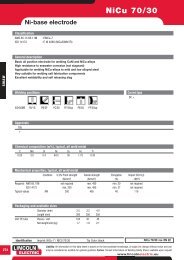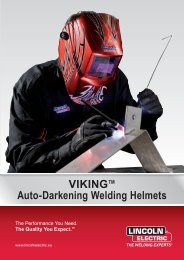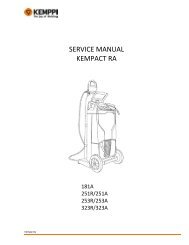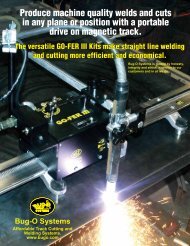mig welding - Rapid Welding and Industrial Supplies Ltd
mig welding - Rapid Welding and Industrial Supplies Ltd
mig welding - Rapid Welding and Industrial Supplies Ltd
Create successful ePaper yourself
Turn your PDF publications into a flip-book with our unique Google optimized e-Paper software.
Additional Metal Surcharge(s) May ApplyTIPSBronze <strong>Welding</strong> <strong>and</strong> BrazingSifbronzingFor successful ‘bronze <strong>welding</strong>’ or‘sifbronzing’, parts must be clean <strong>and</strong> for optimum strength a 60º - 90º veepreparation is required. Using leftward <strong>welding</strong> technique, the parts should be heated with an oxidising flame to a‘dull red’, before introducing the Sifbronze rod <strong>and</strong> flux. Overheating must be avoided, as this will lead to porosity<strong>and</strong> inferior work.It is essential that the joint faces are tinned. A drop of Sifbronze appears to collapse <strong>and</strong> spread across the metalface. If the drop stays as a globule, the metal is either too hot, too cold or dirty. The gap between the tinned facesis now filled with a weave action. It may be necessary to carry out further ‘weld runs’, building up the joint.Sifbronze flux plays an important role not just cleaning the metal, but it covers the weld pool surface, preventingfurther oxidation of the molten bronze.Bronze <strong>welding</strong> cast ironPrior to ‘welded fabrications’, engineers would use cast iron to produce a whole range of products from smalldomestic items (mangles, mincers, mowers) to large industrial parts (agricultural equipment, civil engineeringbrackets <strong>and</strong> fixings, cylinder blocks, machine tool frames etc). Cast iron is a very hard, but brittle material, whichcan be easily machined.Since it is brittle, there is a tendency for it to fracture, especially if a part is subjected to a sudden impact, such asa casting being dropped on a protruding fixing lug or bracket. A repair of this nature does not require a colourmatch, so oxy-acetylene sifbronzing (or bronze <strong>welding</strong>) will be considered. The joint must be prepared bygrinding back the surface <strong>and</strong> producing a ‘vee’ preparation if the material is thick.The first task is to seal the carbon into the cast iron, by ‘buttering’ both faces of the joint. This is done by usingbrazing rod (Sifbronze No 1) <strong>and</strong> st<strong>and</strong>ard Sifbronze flux, to cover each face with a layer of brazing material.Next, the two parts are positioned so that the joint can be completed by bronze <strong>welding</strong> between the two‘buttered’ faces.This produces a strong joint, which is very visible, unless dressed <strong>and</strong> painted. The process does not require theparts to be pre-heated, as necessary when full fusion <strong>welding</strong> cast iron.Brazing copper to copperCopper to copper joints produced with SIFCUPRON, do not require the addition of flux, as the phosphorusprovides a self-fluxing action. It is necessary for the parts to overlap with a joint gap of 0.05 to 0.12mm. The gapshould not exceed 0.4mmAs copper is a very good thermal conductor, the heat must be applied quickly, taking great care not to overheat<strong>and</strong> cause embrittlement. If joint strength <strong>and</strong> ductility are important, Sifcupron No 17-2Ag or 17-5Ag should beused in preference to No 17. Sifcupron No 17-15Ag is more tolerant if joints are not close fitting.On occasions, there is the need to braze copper to brass (perhaps a brass flange to a copper pipe). Provided it isa suitably designed joint, a copper/phos alloy with an inclusion of silver (such as Sifcupron No 17-2Ag) will beideal. However in order to get the alloy to bond with the brass, it is necessary to use a flux, such as Sifsilcopperor Sifbronze.Sifcupron is not suitable for brazing nickel alloys, ferrous metals or where the joint is subject to hot sulphurousgases or oxidising atmosphere above 200ºC.Silver SolderingAs with all brazed joints, preparation <strong>and</strong> cleaning of the workpiece is essential to produce a successful joint.When silver soldering, lap type joints (rather than butt) are preferred <strong>and</strong> the recommended clearance is 0.04 to0.15mm.www.<strong>Rapid</strong><strong>Welding</strong>.comApply SIF Silver Solder flux to both joint faces before assembling the parts. Using a neutral flame, heat assemblyquickly <strong>and</strong> evenly, avoiding overheating the silver solder (wipe rod on joint rather than melting it directly in theflame). Use in a well ventilated area <strong>and</strong> be aware of health <strong>and</strong> safety procedures.To silver solder stainless, a high silver content alloy is required (such as SIF Silver Solder No 43 — 55% Ag Cdfree) <strong>and</strong> a suitable flux (SIF Flux - Silver Solder). Alternatively, a ‘nickel bronze’ brazing rod suchas Sifbronze No 2 together with ‘Tool Tipping/Brazing Stainless’ flux (note: do NOT useStainless flux as it is for gas <strong>welding</strong> of stainless).130



